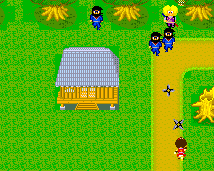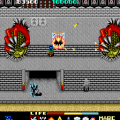Capcom’s Commando is usually hailed as the originator of the run-n-gun genre, but Sega’s Ninja Princess actually came out two months earlier, if Capcom’s official company history and Enterbrain’s Sega Arcade History are to believed, and is in some ways the more advanced concept. Where Commando is for all intents and purposes a reprise of Taito’s Front Line from 1982, more refinement than evolution, Ninja Princess brings a fresh setting and interesting new elements.
But maybe the world wasn’t yet ready to embrace an action game with a cute little girl as the star. Outside of Japan, the title was changed to the not so effeminate Sega Ninja, or just Ninja, while keeping all the graphics as they were, but that didn’t help it much. The game got a few Japan-exclusive home ports and a sequel that toughened up the look and “corrected” the “mistake” of the female protagonist, replacing her with a ninja dude that has to save her instead. It was too little, too late. The Ninja is fairly well remembered as far as early Master System games go, but couldn’t make much of a splash in the wake of Commando and its many martial imitators.
Ninja Princess opens with a short cutscene of the princess Kurumi getting carried away in a palanquin – her castle Kanten has been seized by the traitor Zaemon Gyokuro, who obviously wants to get rid of her. But she escapes, transforms into a kunoichi and sets out to regain her home. Even though it’s basically all about running around killing people with knives, Ninja Princess clearly wants to be a girly game. Everything is bright and colorful with cartoon-like proportions, and when Kurumi gets hit by an enemy, she just sits on the floor and starts crying. It’s hard to resent its stereotyping, though, cause it’s just cute as a button – no surprise here, after all the graphics were designed by Flicky artist Yoshiki Kawasaki and Reiko Kodama of Phantasy Star fame. (The only other known staff member is main programmer Rikiya Nakagawa, who would later take the lead of Sega AM2 / Wow Entertainment, until his departure from the company in 2003.)
Those familiar with Commando will feel right at home with Ninja Princess. The first button works just the same as Super Joe’s gun in Capcom’s hit, firing in whatever direction the character is currently moving to. It circumvents Commando‘s great weakness – the inability to fire independently of the movement, aside from the very limited grenades – without making things as complicated as they were in Front Line, by introducing a secondary fire button, that always fires straight up the screen. Projectiles also destroy each other when clashing together, so the ninja princess’ weapons are at the same time a means of defense. But not the only one: The third and final button makes the princess use her ninja skills to disappear into dust for a second to avoid enemy attacks. Different to most shooting games, merely touching an enemy doesn’t kill you, and other than Commando the stages also scroll backwards (as they do in Front Line). This is only ever used once by the level design to introduce a dead end, but opens up new strategies of retreating and luring enemies into unfavorable positions.
The enemy forces chiefly consist of various types of ninjas; swordfighting ninjas, shuriken-throwing ninjas, leaping ninjas, warping ninjas, invisible ninjas, red ninjas, green ninjas, purple ninjas, blue ninjas with black masks, blue ninjas with pink masks… Godfrey Ho would squeal with joy at the sight of this game. While maybe visually monotonous, every type has its own attack patterns and requires different tactics. There are also a few samurai-type enemies, and at the end of most stages awaits the blond (redhead when he gets angry) ninja lieutenant Ninniku, before the gun-wielding Zaemon takes matters in his own hands later in the game.
Many of the foes drop bonus items when slain. They all just factor into the scoring, with one exception: Picking up a ninja scroll kicks of a faster background tune and enables Kurumi to throw huge shuriken in place of her standard knives for the rest of the stage. These can blast through enemies, killing several in one hit and making it possible to reach a hit ratio above 100%, which results in a fat score bonus at the stage end evaluation. Hidden Buddha statues and scarecrows can also be found at random spots, a final opportunity to score even higher.
To prevent things from getting too monotonous, special setpiece stages are thrown in every once in a while. First the princess is attacked by a pack of ninja wolves in an auto-scrolling stage, before she has to evade falling boulders and a stampede of horses. Finally, the castle walls have to be scaled twice to reach the inner chambers for the final showdown with an angry rapid fire Zaemon. Then, followed by a short nonsensical ending sequence, the game keeps looping with slightly increased difficulty, in the usual vintage arcade fashion.
Ninja Princess was no doubt one of the better overhead run-n-gun shooters out in the mid-’80s. The controls are spot-on, and Kurumi’s three moves offer enough tactical variety, beyond what the enemy patterns simply require: Do you fill the sky with a swarm of shuriken to pave the way, or target your shots to aim for the 100% hit ratio? The game is demanding and requires some memorizing of ambush spots, but remains manageable throughout with a bit of practice. Hostile ninjas tend to attack in huge groups, but it’s not quite the constant pressure exerted by Commando‘s endlessly respawning soldiers. That also highlights the game’s one bigger flaw compared to its prime competitor, though: Sometimes the pacing can get a bit bumpy, when you have to keep walking on to trigger the next wave of foes, especially when you’ve retreated backwards during the last attack. It certainly makes for a more deliberate pace, although it never gets slow or boring, outside of the rather arduous climbing stages.
Although the Mark III was already out by the time, Sega still ported Ninja Princess to the outdated SG-1000 in 1986. This small home version is three stages shorter, and unfortunately the missing ones are all the fun event stages – only the two castle walls for climbing remain. The other stages remain faithful to the original, but without the variety the game easily gets just as monotonous as any other mediocre example of the genre.
To offer that extra bit of replay value a console release needs over the arcade, the final level was simply hidden behind an obscure unlocking sequence – only after finding the five secret scrolls by stepping on arbitrary locations throughout the game (and – in one case – finishing the previous stage with 100% hit rate) the way into the inner castle is revealed to the princess. Without this, the game starts from the beginning after beating stage 12, though the scrolls found in the first run remain in the inventory.
The controls are mostly the same, but because Sega’s home hardware lacked a third controller button, Kurumi now disappears when both fire buttons are pressed together. Thus it’s easy to accidentally fire before activating the technique, which can be annoying when aiming for the 100% hit rate. Worse is the scrolling though: Only when reaching near the top of the screen, the whole picture just jumps a big step forward, where the enemy ninjas already wait with their shurikens to inflict many cheap deaths. The cute animations in the intro and ending are also gone, and the reward for finding and beating the hidden level is nothing more than a short Japanese text message.
This variant was also published for MSX computers through Pony Canyon (dated June 1986). As usual for ports between the two technologically very similar systems, it is exactly the same. Decades later, Eduardo Mello ported Ninja Princess to the ColecoVision, where it was unofficially released by Team Pixelboy, with a neatly updated interpretation of the cover art by Studio Cutepet. The software itself is once again indistinguishable from its counterparts.
Despite the many, many compilations and direct-to-download re-releases Sega keeps putting out frequently, Ninja Princess has only made the cut one single time. Bundled with some other arcade relics (Samurai, Monaco GP, Star Jacker, Sindbad Mystery and Doki Doki Penguin Land), it appeared on the Sega Ages Memorial Selection Vol. 2, once again only in Japan. This one is based on the arcade version, with the pixel art subtly retouched for improved coloring and shading. Due to the Saturn’s limited flexibility in screen resolution, the game appears pillarboxed, though. (Still preferable to a linear-stretched image.)
Screenshot Comparisons
The Ninja / Ninja Princess 1 Mega Ban (忍者プリンセス1メガ版) – Master System (November 8th, 1986)
Despite the change in tone and protagonist – instead of being the princess, the hero Kazamaru is a dude out to save the princess – The Ninja rather is actually closer to another port of the original game than a sequel. It reintroduces the horse, river, and boulder stages, and trims out some of the more redundant ones (thankfully the castle climbing isn’t repeated anymore) for a total of 14.
Most stages remain virtually the same as the SG-1000 version, some have minor changes and cosmetic additions, and only one feels completely new. The best improvement is different music tunes for the individual stages. None of them are particularly memorable, but at least one doesn’t have to listen to the same two tracks for the whole game.
The gameplay likewise has hardly changed at all. Even though the ninjas aren’t as colorful anymore, they keep their various patterns, the only addition being some harmless fire-breathers. As on the SG-1000, five secret scrolls have to be found to access the final level. There’s a new ninja scroll type that makes the ninja go faster, but that only means that his standard speed feels much too slow once you lose it again (which now only happens when losing a life, the power-ups are kept when completing a stage). All the bonus score pickups are gone, though.
The Ninja is still a decent game, but the complete lack of real improvement over the previous versions makes it seem rather lazy. At the same time it sacrifices the original’s identity to cater to the tough guy action game market, where it simply isn’t impressive or fresh enough to compete. The box text declares: “The time is Japan’s colorful past,” but it really doesn’t seem that colorful, anymore. Thus was the end of Ninja Princess, leaving the cutesy sector of the genre to Taito’s KiKi KaiKai, which just had its first release around the time and boasted stages that scroll into four directions and huge bosses, all while raising exponentially the Japanese quirkiness factor that Sega had abandoned all too eagerly.


